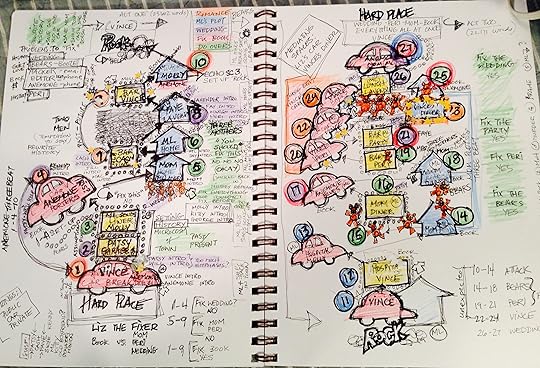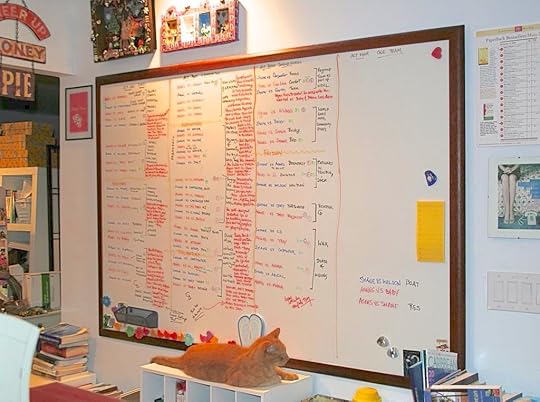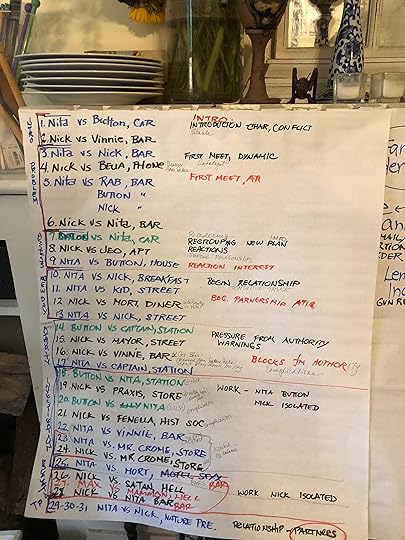Keys vs. Pens
I write on a computer. I love writing on a computer. There is no doubt in my mind that if computers hadn’t been invented, I would never have written a book. (I wrote my first master’s thesis on a typewriter. That was enough long -form-with-witeout typing.) Sometimes I have to diagram to see relationships, overlapping plots, anything that’s not linear and for that I have a mapping program (Curio, highly recommended). My relationship with my laptop is intense and ongoing.

Until I get to the two-thirds (roughly) point in the novel. Then I lust for colored pens.
I don’t know for sure why I dump my laptop then, but when I can see the entire book in my head, I need grid paper and sketchbooks and colored pens. I need a print-out of the book and colored pens. And most of all, I need a whiteboard and, yep, colored pens.
Okay, I do know some of this. I know I love the non-linearity of the grid paper and cards, the ability to go in all directions at once as I diagram my plot and character arcs over and over again as I write. Sometimes I doodle ideas and that’s harder on a computer, although there’s my iPad screen with its pen, but I think I just I crave the feel of paper under my hand, I want to see the ink flow in the sketchbooks, I want to be connected to the experience, not just feeding information that magically appears on a screen I’m not supposed to touch (that’s the laptop, not the iPad, my fingerprints are all over the iPad).

The picture above is the first two acts of Lavender’s Blue. The majority of the scenes there are either in cars or houses; Liz trying to escape or Liz trapped, and I wanted to see the distribution. The names inside the icons are the antagonists. The teddy bears are a motif throughout and I wanted to see how they were placed in the story. It’s act-by-doodle, and it gives me a different way to picture (in this case literally) the plot, and it’s all in a notebook that’s much harder to lose than a piece of paper. Plus because it’s a sketchbook, the paper is a lot tougher and I can do some real damage with markers without destroying the whole thing. Also it’s fun.
I do know why I need the print-out; it’s because the book looks different on the page than it does on the screen. It’s like meeting somebody you only know at work when you’re at the grocery store; you see a different person. I print out the book and see a different story. All my mistakes glare; connections I’d missed become obvious; parts that drag, drag more; parts that are too fast whiz by. I love the print-out stage because I get to read a new book.
I’m less sure why I lust for a whiteboard at this stage. There is real value in being able to see the entire book on the wall before me, divided into acts, blocked into scenes and scene sequences, color-coded as to point-of-view character, symbols indicating subplots. It gives me the entire novel in one graphic. But I’m getting the same thing, basically, from the easel-sized post-its I bought until I can put up a whiteboard, and it’s not what I want. I need to see it on a whiteboard, not four giant Post-its.
This is the first three acts of Agnes on my old whiteboard. I miss my old whiteboard. (That’s Charlie reclining below the whiteboard; I miss him, too.)

If the visuals here look familiar, it’s because I grabbed them off an old Argh questionable post (question from Deb Blake, thank you, Deb)
And for right now, as I mentioned above, I’m using giant post-its for Nita. It’s just not the same.

It is still valuable, though. Among other things, this first pass shows me that I’ve completely borked the Button/Max subplot in this act. Back to the drawing board giant Post-it.
Still, I’ll never give up my laptop for writing the drafts. The idea of writing a novel longhand . . . shudder . . . although people whose work I respect prefer it. Pat Gaffney always wrote her books in longhand, and Krissie (Anne Stuart) often does:
“It depends on the book, depends if I’m stuck, etc. Some books just ask to be written in longhand – it’s a mystery. I started it when I got blocked and it would knock me out of it, and I did it for love scenes, probably because of the more tactile feel (redundant) of the ink and the paper. I’m pickier about paper than pens – has to be Clairefontaine, which is like silk, but mostly any fountain pen will do. Books just demand to be written certain ways and I don’t fight it. Works for me.”
The paper thing is interesting–Krissie feels about Clairefontaine the way I feel about graph paper and sketchbook pages–but I think her penultimate sentence in the key. I cannot explain why I need the whiteboard, but I know I shouldn’t fight it. The Girls in the Basement know what they need, so I should just order the damn whiteboard, rearrange my living room to open a wall for it, and then get back to figuring out Button and Max’s subplot arc.
The writer’s heart knows what it wants and in my case, that’s a white board and many, many colored markers.

The post Keys vs. Pens appeared first on Argh Ink.




